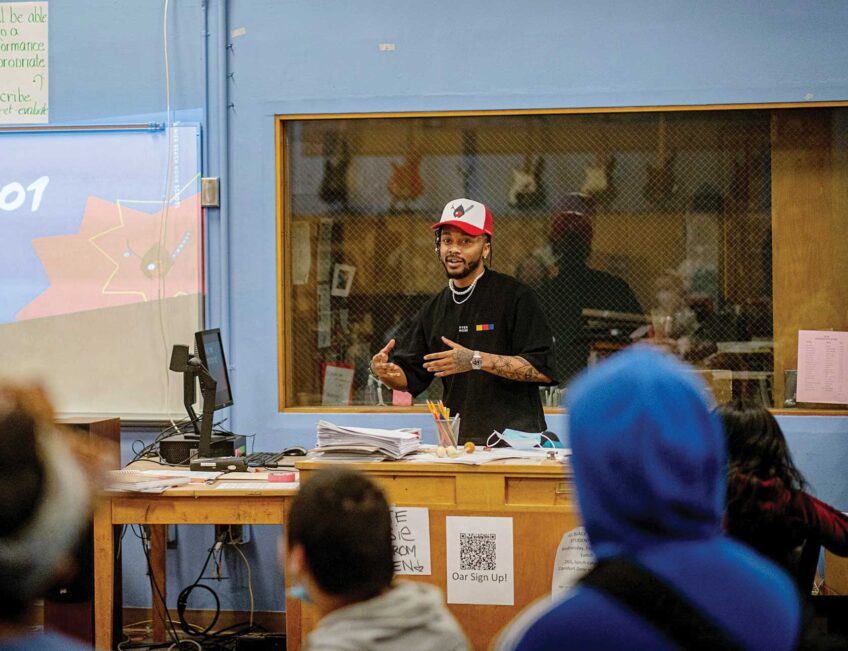
Reversing the absence of Black men on college campuses starts with helping Black boys see themselves — by growing the ranks of Black male teachers in K-12 classrooms.
Studies show Black K-12 teachers pay dividends: Black boys see them as role models and inspiration, while white children show improved grades. Proportionately, HBCUs train and produce more black teachers than predominantly white institutions.
When students see themselves in their education, it lights a spark. I know, because it happened to me.
In sixth grade, I signed up with some friends for a quiz-bowl style competition called the Black Facts Challenge. We studied as much as we could about Black Americans’ contributions to this country — Booker T. Washington’s founding of the Tuskegee Institute, the life of Duke Ellington, and more. The competition culminated in a citywide championship, which our team won.
I still remember how connected I felt to those remarkable achievements I studied. Seeing myself, my family and my history reflected in history books made me hungry to keep learning, and it directly influenced my path as a student and educator. It’s a big reason why I’m the CEO of DonorsChoose, a national nonprofit helping teachers provide their students with resources to succeed in the classroom and beyond.
That moment of recognition, connection and pride is a moment every child deserves. But recent news about the growing gender gap in college enrollment, particularly at our nation’s historically Black colleges and universities — and the profound shortage of Black men in the K-12 teaching ranks — could mean fewer Black boys in our nation’s K-12 classrooms experience that spark.
There’s no question that Black educators have a positive impact in the classroom. Studies have shown that Black students who have at least one Black teacher are more likely to graduate high school and attend college. Studies also have found that white students taught by people of color scored higher in reading and math.
When Black men are at the chalkboard, there’s an added bonus: The largest-ever survey of male teachers of color —conducted by DonorsChoose — found that Black male teachers spent more time counseling and mentoring students than any other group.
HBCUs play a significant role in making this possible. They produce half of all Black teachers in the United States, using teacher training programs that have been hailed as models for the rest of the country to follow. Studies show that HBCU-educated teachers are more engaged with their students and achieve better academic outcomes than their non HBCU-educated peers.
Yet Black men are still underrepresented in our classrooms, making up just 2% of the nation’s public school educators. And those already teaching are burning out at an alarming rate.
Fewer Black men in HBCUs means fewer Black men in the classroom, which in turn means fewer Black boys will get the benefit — that spark — of seeing role models who can encourage their thirst for learning.
In a recent survey, one in three Black teachers said they felt strongly that they might leave their jobs in the coming year, the highest of any group. There are many reasons, from low pay and high student loan debt to lack of support, disrespect in the workplace and more.
Fewer Black men in HBCUs means fewer Black men in the classroom, which in turn means fewer Black boys will get the benefit — that spark — of seeing role models who can encourage their thirst for learning. One less Black male teacher means one less Black boy will see education as a career possibility, causing the pool of Black male teachers to shrink even further.
Fortunately, there are steps we can take, right now, to retain the Black teachers we have and strengthen the pipeline for the next generation of Black educators. It begins with supporting HBCUs so they can recruit more young men, help them pay for college, and help more Black teachers enter the workforce.
Teacher recruiting efforts can be strengthened through outreach to HBCUs and their alumni networks. Funders can ensure their investments support programs that help all students, including Black high school students, learn about and enter into teaching careers.
All of us can support HBCU-educated teachers in our own communities — men and women who make such a powerful difference in the lives and futures of our children. Helping fill their classroom needs enables them to introduce innovative ideas, and has been shown to make teachers 22% more likely to stay in the classroom.
That’s why DonorsChoose launched a Quad to Classroom tool to support HBCU alumni teaching in public schools across the United States. It is one of several ways to help HBCU-educated teachers to tap into their own insight and expertise to provide the best academic experience for their students, as well as to spend less money out of pocket on necessary school supplies.
The future depends on our ability to inspire every student, enabling them to connect and engage with their education. Investing in Black educators and expanding the pool of Black men teaching in our classrooms are crucial to making those things a reality.
This article first appeared on Word in Black.







Leave a Reply
You must be logged in to post a comment.